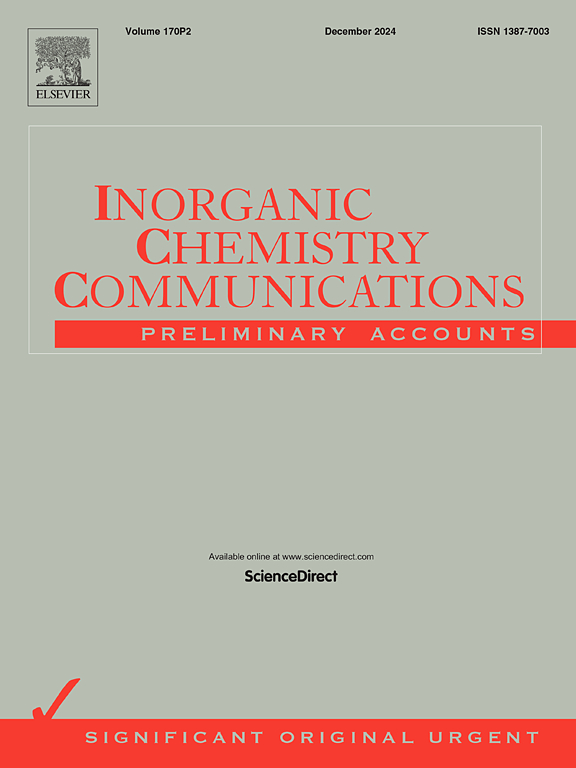Electrochemical performance enhancement of ZnO/g-C3N4 nanocomposites using urea and thiourea precursors for supercapacitor applications
IF 4.4
3区 化学
Q1 CHEMISTRY, INORGANIC & NUCLEAR
引用次数: 0
Abstract
Supercapacitors are becoming strong options for energy storage devices. They offer quick charging and discharging, high density, and long-lasting stability over many cycles. This research focuses on the synthesis of graphitic carbon nitride (g-C3N4) and sulfur-doped graphitic carbon nitride using urea (U-g-C3N4) and thiourea (TU-g-C3N4), respectively, along with the fabrication of ZnO/g-C3N4 based nanocomposites for supercapacitor electrode applications. The study aims to enhance electrochemical performance by integrating ZnO with U-g-C3N4 and TU-g-C3N4 as separate nanocomposites, leveraging their synergistic properties to improve energy storage capabilities. The fabricated ZnO/U-g-C3N4 and ZnO/TU-gC3N4 nanocomposites were characterized using X-ray diffraction (XRD), Fourier transform infrared spectroscopy (FTIR), scanning electron microscopy (SEM), and UV–Vis spectroscopy to analyze their structural, morphological, and optical properties. Furthermore, electrochemical tests, including cyclic voltammetry (CV) and electrochemical impedance spectroscopy (EIS), were conducted to evaluate their electrochemical performance. The results indicated that the ZnO/TU-g-C3N4 nanocomposites achieved an impressive specific capacitance of 415F/g at a 50 mV/s, which is significantly higher than the capacitance values observed for ZnO/U-g-C3N4 (408F/g) and ZnO (223F/g). Furthermore, ZnO/U-g-C3N4 and ZnO/TU-g-C3N4 demonstrated superior electrochemical stability, this indicates improved redox activity and superior charge storage ability. The results underscore the potential of ZnO/U-g-C3N4 and ZnO/TU-g-C3N4 nanocomposites as effective electrode materials for advanced supercapacitor applications.

使用尿素和硫脲前驱体提高 ZnO/g-C3N4 纳米复合材料的电化学性能,以应用于超级电容器
超级电容器正在成为能量存储设备的有力选择。它们提供快速充放电,高密度和多次循环的持久稳定性。本研究的重点是分别以尿素(U-g-C3N4)和硫脲(TU-g-C3N4)为原料合成石墨氮化碳(g-C3N4)和硫掺杂石墨氮化碳(TU-g-C3N4),并制备用于超级电容器电极的ZnO/g-C3N4纳米复合材料。该研究旨在通过将ZnO与U-g-C3N4和TU-g-C3N4作为单独的纳米复合材料集成,利用它们的协同特性来提高储能能力,从而提高电化学性能。采用x射线衍射(XRD)、傅里叶变换红外光谱(FTIR)、扫描电镜(SEM)和紫外可见光谱(UV-Vis)对制备的ZnO/U-g-C3N4和ZnO/TU-gC3N4纳米复合材料进行了表征,分析了其结构、形貌和光学性能。此外,通过循环伏安法(CV)和电化学阻抗谱(EIS)等电化学测试来评价其电化学性能。结果表明,ZnO/TU-g-C3N4纳米复合材料在50 mV/s下的比电容值为415F/g,显著高于ZnO/U-g-C3N4的408F/g和ZnO的223F/g。此外,ZnO/U-g-C3N4和ZnO/TU-g-C3N4表现出优异的电化学稳定性,这表明ZnO/U-g-C3N4具有更好的氧化还原活性和更好的电荷存储能力。研究结果强调了ZnO/U-g-C3N4和ZnO/TU-g-C3N4纳米复合材料作为先进超级电容器电极材料的潜力。
本文章由计算机程序翻译,如有差异,请以英文原文为准。
求助全文
约1分钟内获得全文
求助全文
来源期刊

Inorganic Chemistry Communications
化学-无机化学与核化学
CiteScore
5.50
自引率
7.90%
发文量
1013
审稿时长
53 days
期刊介绍:
Launched in January 1998, Inorganic Chemistry Communications is an international journal dedicated to the rapid publication of short communications in the major areas of inorganic, organometallic and supramolecular chemistry. Topics include synthetic and reaction chemistry, kinetics and mechanisms of reactions, bioinorganic chemistry, photochemistry and the use of metal and organometallic compounds in stoichiometric and catalytic synthesis or organic compounds.
 求助内容:
求助内容: 应助结果提醒方式:
应助结果提醒方式:


